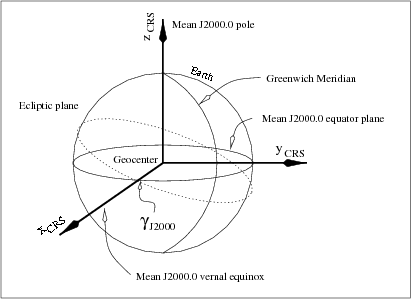If you wish to contribute or participate in the discussions about articles you are invited to contact the Editor
Conventional Celestial Reference System
Jump to navigation
Jump to search
| Fundamentals | |
|---|---|
| Title | Conventional Celestial Reference System |
| Author(s) | J. Sanz Subirana, JM. Juan Zornoza and M. Hernandez-Pajares, University of Catalunia, Spain. |
| Level | Medium |
| Year of Publication | 2011 |
This reference system is also known as Earth Centred Inertial (ECI) [footnotes 1] and is mainly used for the description of satellite motion. CRS has its origin in the Earth's centre of mass or Geocentre, its fundamental plane is the mean Equator plane (containing the Geocentre) of the epoch J2000.0, and the principal axis [math]\displaystyle{ x }[/math] is pointing to the mean Vernal equinox of epoch J2000.0. The three axis defining this coordinate are shown in Figure 1.
- x[math]\displaystyle{ _{CRS} }[/math] axis: Its origin is the geocentre, the Earth Centre of Mass, and its direction is towards the mean equinox at J2000.0 (i.e., the intersection between the J2000 equatorial plane and the ecliptic plane).
- z[math]\displaystyle{ _{CRS} }[/math] axis: This axis is defined by the direction of the earth mean rotation pole at J2000.0.
- y[math]\displaystyle{ _{CRS} }[/math] axis: Is the orthogonal to the formers ones, so the system is right handed.
Notes
- ^ Strictly speaking this is a quasi-inertial system because of the annual motion of the earth around the sun, and thus it is subjected to a certain acceleration, but can be thought as inertial over short periods of time.


